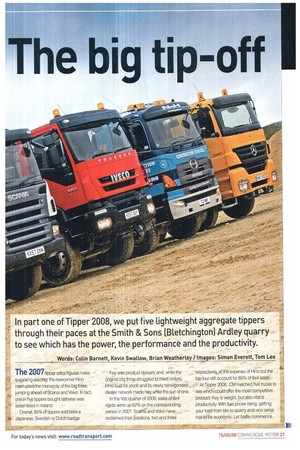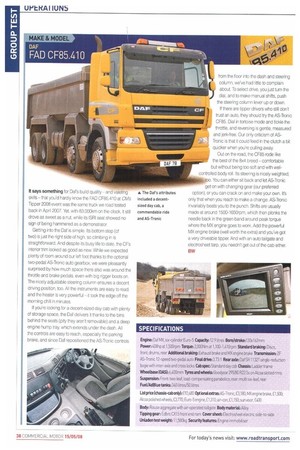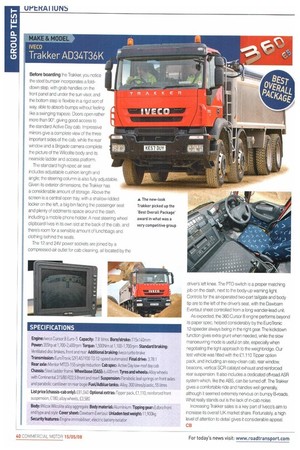The big tip off
Page 37

Page 38

Page 39

Page 40

Page 41

If you've noticed an error in this article please click here to report it so we can fix it.
In part one of Tipper 2008, we put five Lightweight aggregate tippers through their paces at the Smith & Sons (Bletchington) Ardley quarry to see which has the power, the performance and the productivity.
Words: Colin Barnett, Kevin Swallow, Brian Weatherley / Images: Simon Everett, Tom Lee The 2007 tipper sales figures make surprising reading: the newcomer Hino Interrupted the monopoly of the big three, jumping ahead of Scania and Volvo. In fact, one in five tippers bought last year was assembled in Ireland.
Overall, 85% of tippers sold bore a Japanese, Swedish or Dutch badge.
Key was product delivery and, while the original big three struggled to meet orders, Hino built for stock and its newly reinvigorated dealer network made hay while the sun shone. In the first quarter of 2008, sales of 8x4 rigids were up 62% on the corresponding period in 2007. Scalia' and Volvo have reclaimed theiri5ositions, two and three
respectively, at the expense of Hino but the top four still account for 85% of 8x4 sales.
At Tipper 2008, CM matched five trucks to see which could offer the most competitive product. Key is weight, but also vital is productivity. With fuel prices rising, getting your load from site to quarry and vice versa has to be economic. Let battle commence.
It says something for Oaf's build quality and valeting skills — that you'd hardly know the FAD CF85.410 at CM'S Tipper 2008 event was the same truck we road tested back in April 2007. Yet. with 83,000km on the clock, it still drove as sweet as a nut, while its ISRI seat showed no sign of being hammered as a demonstrator.
Getting into the Daf is simple. Its bottom step (of two) is just the right side of high, so climbing in is straightforward. And despite its busy life to date, the CF's interior trim looked as good as new. While we expected plenty of room around our left foot thanks to the optional two-pedal AS-Tronic auto gearbox, we were pleasantly surprised by how much space there also was around the throttle and brake pedals, even with big rigger boots on. The nicely adjustable steering column ensures a decent driving position, too. All the instruments are easy to read. and the heater is very powerful — it took the edge off the morning chill in minutes.
If you're looking for a decent-sized day cab with plenty of storage space, the Oaf delivers it thanks to the bins behind the seats (pity they aren't removable) and a deep engine hump tray, which extends under the dash. All the controls are easy to reach, especially the parking brake, and since Daf repositioned the AS-Tronic controls
from the floor into the dash and steering column: we've had little to complain about. To select drive, you just turn the dial, and to make manual shifts, push the steering column lever up or down. If there are tipper drivers who still don't trust an auto, they should try the AS-Tronic CF85. Dial in tortoise mode and tickle the throttle, and reversing is gentle, measured and jerk-free. Our only criticism of ASTronid is that it could feed in the clutch a bit quicker when you're pulling away.
Out on the road, the CF85 rode like the best of the 8x4 breed — comfortable but without being too soft and with wellcontrolled body roll. Its steering is nicely weighted, You can either sit back and let AS-Tronic get on with changing gear (our preferred option), or you can crack on and make your own. It's only that when you reach to make a change, AS-Tronic invariably beats you to the punch. Shifts are usually made at around 1500-1650rpm, which then plonks the needle back in the green band around peak torque where the MX engine goes to work. Add the powerful MX engine brake (well worth the extra) and you've got a very driveable tipper. And with an auto tailgate and electrosheet tarp, you needn't get out of the cab either. BW Unlike most of the tippers on parade, the Hino 700 is a genuine working vehicle, with 15,000km behind it in the hands of Scottish operator NWH Construction Services, and sporting a locally built Jimmy Kelly body.
Cab access is good; it has a wide-opening door, although a weak 'stay open' detent means it tends to bounce back. The bottom step is fixed, but only slightly vulnerable below the steel bumper.
The cab is a low-roof 'rest sleeper, with a basic narrow bunk more suited to a day-time snooze than regular nights out. Good mirrors and a Vision Alert rear camera give good visibility, but the rear cab wall is unglazed.
The cab is well equipped and has lots of general storage, including a useful A4 document tray between the seats. The instrument panel is clearly laid out, but some of the controls are rather haphazardly arranged. The indicators on the right are a sure way to lose friends, while the left stalk controls the intermittent wipers and, in an unusual approach, the action that would normally flash the headlamps operates the hazard warning lights.
The PTO and tip controls live on a convenient combined panel near the left knee, close to a rocker switch for the Harsh sheeting device, which pulls the sheet up to the headboard; a PM Onboard weighing display is mounted in the centre of the dash. A huge red warning light advises when the diff locks are engaged.
The 410 engine comes with EcoRun, a switch on the dash that reduces power output to 360hp for more economical empty running but as we were running at a full 32 tonnes, we didn't sample it for real. It was lively enough with 410, though. After being spoiled by a variety of auto boxes lately, the ZF four-over-four 16-speeder was a bit of a culture shock. The change was rather recalcitrant in the third/fourth plane, while the very close gate needed a bit of concentration. A painful shoulder problem meant the slap-across to low range was a bit uncomfortable, while reverse needed two hands but that's not really the truck's fault.
The ride is firm but not uncomfortable, while the steering felt less nervous than the Iveco driven beforehand. This all the more surprising given that during its life, the Nino has ended up with four or five different (albeit good-quality) brands of tyre randomly distributed around the axles. CB
Before boarding ihe Trakker, you notice the steel bumper incorporates a folddown step, with grab handles on the front panel and under the sun visor, and the bottom step is flexible in a rigid sort of way, able to absorb bumps without feeling like a swinging trapeze. Doors open rather more than 90, giving good access to the standard Active Day cab. Impressive mirrors give a complete view of the three important sides of the cab, while the rear window and a Brigade camera complete the picture of the Wilcolite body and its nearside ladder and access platform.
The standard high-spec air seat includes adjustable cushion length and angle; the steering column is also fully adjustable. Given its exterior dimensions, the Trakker has a considerable amount of storage. Above the screen is a central open tray, with a shallow-lidded locker on the left, a big bin facing the passenger seat and plenty of oddments space around the dash, including a mobile phone holder. A neat steering wheel clipboard lives in its own slot at the back of the cab, and there's room for a sensible amount of lunchbags and clothing behind the seats.
The 12 and 24V power sockets are joined by a compressed-air outlet for cab cleaning, all located by the driver's left knee. The PTO switch is a proper matching job on the dash, next to the body-up warning light. Controls for the air-operated two-part tailgate and body tip are to the left of the driver's seat, with the Dawbarn Evertaut sheet controlled from a long wander-lead unit.
As expected, the 360 Cursor 8 engine performs beyond its paper spec, helped considerably by the EuroTronic 12-speeder always being in the right gear. The kickdown functbn gives extra grunt when needed, while the slow manoeuvring mode is useful on site, especially when negotiating the tight approach to the weighbridge. Our test vehicle was fitted with the £1,110 Tipper option pack, and including an easy-clean cab, rear window, beacons, vertical SCR catalyst exhaust and reinforced rear suspension. It also includes a dedicated off-road ASR system which, like the ABS, can be turned off. The Trakker gives a comfortable ride and handles well generally, although it seemed extremely nervous on bumpy B-roads. What really stands out is the lack of in-cab noise.
Increasing Trakker sales is a key part of lveco's aim to increase its overall UK market share. Fortunately, a high level of attention to detail gives it considerable appeal. CB It took its own sweet time coming, but the Axor eight-wheeler is now fully "embedded" in Merc's UK product range. It has a smaller cab and a noticeably lighter tare weight to the previous Actros 8x4. It's certainly a competent performer thanks to a 12-litre lump and a payload comfortably above the desired 20 tonnes even with the latest Alcoa Workhorse solid wheels, which help keep the muck and bullets away from the
discs. Although its cab sits quite high up; access isn't A The Axor eight-wheeler a problem using the flexible bottom step (of three). It's is a competent performer easy to exit, too. Although we've criticised the position of with a payload above the the Axor's driver's seat desired 20 tonnes
in the past (too far over to the left, so your right shoulder blade feels the edge of the seat upright), on our 3240K it seemed less noticeable.
Inside the Axor's 'K' (for Konstruction) cabin, there's a typically Teutonic, bulletproof trim. You won't have any problems hosing it out, and you've got plenty of storage space, including a full-width bin on the back wall, a deep tray under the dash which takes a clipboard and various pockets and cubby holes, plus a big tray on top of the dash. But you can forget about cross-cab access with that big gear lever for the standard manual box in the way. On the plus side, though, all-round vision is good thanks to slim A-posts and decent mirrors. Even with big boots on, there's plenty of room for your feet around the pedals, and the dash display and park brake layout is good, too. Out on the road, we were reminded just how torquey Merc's straight-six 0M457 is. It pulls down hard to 1,000rpm. and then comes back fighting. As for the double-H pattern on the manual box, you either love 'em or hate 'em... our tester liked this one, which was set up just right in the Axor. Our only grumble with the eight-plus-crawler gearbox is that first (not crawler) is almost too deep, and there's a noticeable gap between sixth and seventh. That said, it combines well with the 12-litre six-pot, so block shifts are easy and quick. You certainly don't need a splitter with this driveline at 32 tonnes, even on steep hills. The Axor's ride is somewhat firm, so when it got a bit bouncy, we locked out the seat and everything was fine. As a jobbing tool, we really rate the Axor apart from one thing its brakes. On our 3240K, they lacked feel and progression and we ended up having to press hard before getting any real result.
BW




























































































































































































